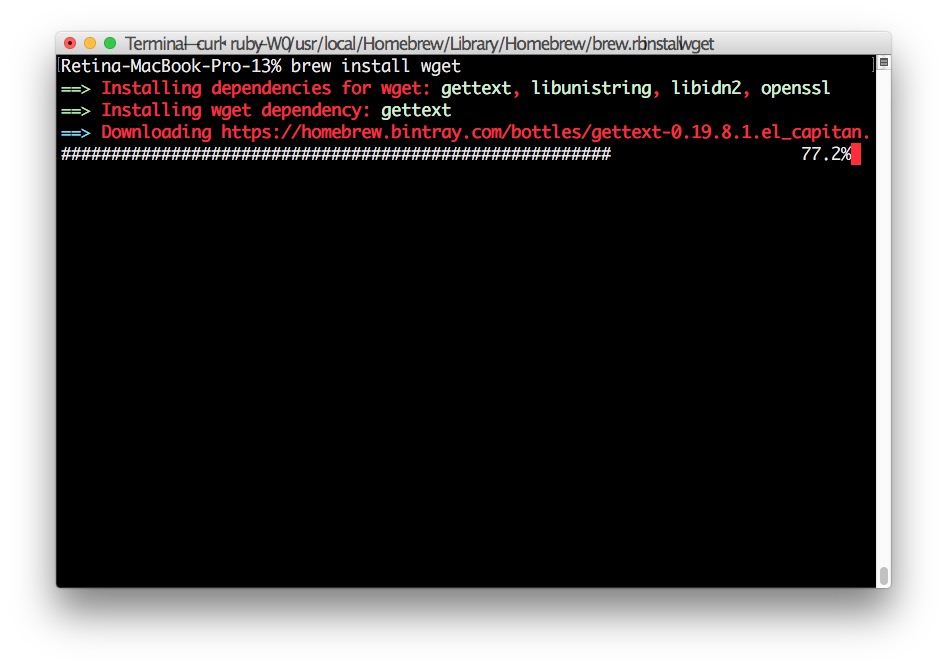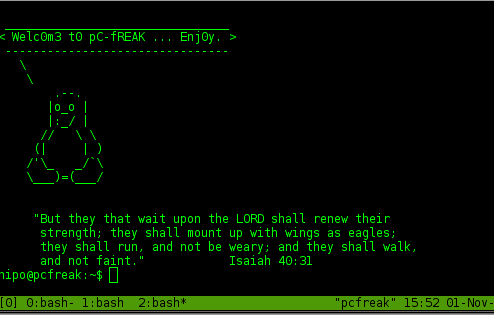- Download Software
- Ipod Install Software
- Mac Os Install Software Command Line Download
- Mac Os Command Line
- Install Commands Mac Os Terminal
- Mac Os Install Software Command Line Online
- Hp Printer Install Software
Dec 10, 2008 Once mounted, installation of the application is typically done by dragging an icon to the Applications folder. The same can be accomplished from the command line using two commands, hdiutil and cp. The following steps show the installation of a popular VNC. Jan 13, 2011 As this is using the command line, you will be using the Terminal application, found in /Applications/Utilities/ on all Macs. If you’re unfamiliar with the command line, it’s probably better to simply install software updates from the Software Update system preference or the Mac App Store. Jun 01, 2020 The version of macOS offered by macOS Recovery might vary in some cases: If macOS Sierra 10.12.4 or later has never been installed on this Mac, Option-Command-R installs the macOS that came with your Mac, or the closest version still available. And Shift-Option-Command-R isn't available. If you erased your entire disk instead of just the startup volume on that disk, macOS Recovery might.
These advanced steps are primarily for system administrators and others who are familiar with the command line. You don't need a bootable installer to upgrade macOS or reinstall macOS, but it can be useful when you want to install on multiple computers without downloading the installer each time.
Download Software
Download macOS
Ipod Install Software
Find the appropriate download link in the upgrade instructions for each macOS version:
macOS Catalina, macOS Mojave, ormacOS High Sierra
Installers for each of these macOS versions download directly to your Applications folder as an app named Install macOS Catalina, Install macOS Mojave, or Install macOS High Sierra. If the installer opens after downloading, quit it without continuing installation. Important: To get the correct installer, download from a Mac that is using macOS Sierra 10.12.5 or later, or El Capitan 10.11.6. Enterprise administrators, please download from Apple, not a locally hosted software-update server.
OS X El Capitan
El Capitan downloads as a disk image. On a Mac that is compatible with El Capitan, open the disk image and run the installer within, named InstallMacOSX.pkg. It installs an app named Install OS X El Capitan into your Applications folder. You will create the bootable installer from this app, not from the disk image or .pkg installer.
Use the 'createinstallmedia' command in Terminal
- Connect the USB flash drive or other volume that you're using for the bootable installer. Make sure that it has at least 12GB of available storage and is formatted as Mac OS Extended.
- Open Terminal, which is in the Utilities folder of your Applications folder.
- Type or paste one of the following commands in Terminal. These assume that the installer is still in your Applications folder, and MyVolume is the name of the USB flash drive or other volume you're using. If it has a different name, replace
MyVolumein these commands with the name of your volume.
Catalina:*
Mojave:*
High Sierra:*
El Capitan: - Press Return after typing the command.
- When prompted, type your administrator password and press Return again. Terminal doesn't show any characters as you type your password.
- When prompted, type
Yto confirm that you want to erase the volume, then press Return. Terminal shows the progress as the bootable installer is created. - When Terminal says that it's done, the volume will have the same name as the installer you downloaded, such as Install macOS Catalina. You can now quit Terminal and eject the volume.

* If your Mac is using macOS Sierra or earlier, include the --applicationpath argument, similar to the way this argument is used in the command for El Capitan.
Use the bootable installer
After creating the bootable installer, follow these steps to use it:
- Plug the bootable installer into a compatible Mac.
- Use Startup Manager or Startup Disk preferences to select the bootable installer as the startup disk, then start up from it. Your Mac will start up to macOS Recovery.
Learn about selecting a startup disk, including what to do if your Mac doesn't start up from it. - Choose your language, if prompted.
- A bootable installer doesn't download macOS from the Internet, but it does require the Internet to get information specific to your Mac model, such as firmware updates. If you need to connect to a Wi-Fi network, use the Wi-Fi menu in the menu bar.
- Select Install macOS (or Install OS X) from the Utilities window, then click Continue and follow the onscreen instructions.
Learn more
For more information about the createinstallmedia command and the arguments that you can use with it, make sure that the macOS installer is in your Applications folder, then enter this path in Terminal:
Catalina:
Mojave:
High Sierra:
Mac Os Install Software Command Line Download
El Capitan:
| Click here to return to the 'Installing packages from the command line' hint |
is that some packages (notably Fink) don't work using this installer application. Kind of frustrating when you need a command-line app on a remote computer and you can't install Fink in order to install the app! :-)
---
www.AcornWebDesigns.com
Quality websites for inexpensive prices (Is that an oxymoron?)
I also discovered this installer command the day that I read the recent article here about installing a no-ip linux client as a startup item. The .pkg that was pointed to by that article did not work via the command line. I had to do it from home. Even then it still didn't seem to be workgin right, though, so I removed it and installed the fink version which seems to be working, once I understood how to set that version up. A fully working command-line installer is much needed, but if it works on some things now that's still pretty good....
---
--- I hate Microsoft and I vote
Mac Os Command Line
cd /
sudo /usr/sbin/installer -pkg /path/to/pkg.pkg -target / ---
4am Media, Inc. Mac OS X Training and Consulting
sudo reboot is a harsh command, I believe you'd use all unsaved documents, I wouldn't recommend doing it this way.
Something like:
sudo osascript -e 'tell application 'Finder' to restart'
Would be much better. It would get canceled if there is unsaved data.
arr, but if your using the cli to install packages most likely the box is on a remote site, so u cant press 'save' or 'don't save' and the restart would time out
there has to be away of avoiding this because it would be nice to be able to restart and / or log out a user via the cli
jameso
---
'The time has come,' the walrus said. 'To talk of many things...'
Then use localhost & port 5900 in your vnc client. You can have the remote machine always running the vnc server, or run it from the ssh shell.
Of course, if you go this route, isntalling via the CLI is pointless since you can just do it via the GUI.

Install Commands Mac Os Terminal
The applescript is all very nice, but if no one is logged into the remote machine is does not work, the response is '29:36: execution error: Application isn't running (-600)' (tested with OS X 10.3.5)
This is great. Now if only I could create packages from the command line rather than using PackageMaker interactively.
You can create packages from the command line. i've done it in 10.4, but haven't tried in 10.5.
in tiger, PackageMaker will load in /Developer/Applications/Utilities/PackageMaker.app
but really all .app's are just folders, so you can call the CLI by /Developer/Applications/Uitilities/PackageMaker.app/Contents/MacOS/PackageMaker
you'll have to feed it a number of flags like -build and -p... i think there's a man page for it somewhere.
Mac Os Install Software Command Line Online
If you look in /usr/sbin/ a couple of utils already stand out because of their name:
AppleFileServer
AppleSystemProfiler
DirectoryService
PasswordService
installer
softwareupdate
am-eject
nvram
system_profiler
appletalk
asr
bootparamd
disktool
screencapture
diskutil
You can find out what they do by looking at their man pages or running them (not as root obviously)

Some of these don't have man pages. Notably (for me):
opendiff - run the cocoa diff utility on two files
scselect - select network location
disktool - I'm sure this does something handy